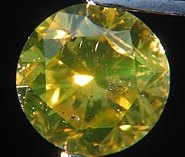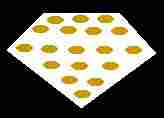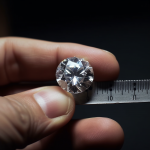Diamond Prices
Read moreHP-HT Treatment Diamonds
HPHT treated Diamonds
Information and prices about HP-HT processed diamonds of type 2A
Some natural brown diamonds can be artificially treated by High Temperature (HT) and High Pressure (HP) to improve its color from brown into white. This can no more be considered as a natural diamond!
Diamonds type 2a, are suitable for this color improvement. HPHT processed diamonds cost 60% less.
That gives you the possibility to buy a D color diamond for the price of a F color.
These Diamonds are only available in big sizes from 3.00 carats and up.
HP HT process of Diamonds type 2A prices
Only very rare Diamonds type 2A containing nitrogen can be processed by High Temperature (HT) and High Pressure (HP) treatment to improve its appearance. It is a similar natural treatment as 3.3 billion years ago when nature create diamonds.
Only less than 1% of all diamonds, the very rare diamonds type 2a, are suitable for this improvement.
HPHT processed diamonds cost less. That gives you the possibility to buy a D color diamond for the price of an F color.
There is not one single difference between Diamonds from type 2 A, who were processed by nature 3.3 billion years ago, and diamonds who are processed artificial HP-HT now. These Diamonds are very rare especially in big sizes.
What happens by HPHT process?
By high temperature and high pressure nitrogen can be eliminated
An HPHT processed diamond can be recognized in gemological laboratory detecting that the diamond is nitrogen free
Detect HPHT treated and synthetic diamonds
Pay attention!
HPHT process is created thanks to very expensive high tech processing machines who did not exist a few years ago. (2001)
The gemological laboratories which delivered diamond certificates before the year 1999 could not detect these characteristics.
It’s a DNA improvement of the diamond that gives the possibility to detect these characteristics.
But nobody can tell if it was natural or artificial. It is the same treatment.
So what?
Buying an HP-HT treated diamond has a genuine value.
Just pay the correct price for HPHT processed diamonds!
About 40 to 50% of the normal price! Consult diamond prices
Consult also cheapest cut
Diamond certificates will mention under “comments”:
HP/HT processed to improve its color.
In the girdle of the diamond you will find this engraved!
When not type A2 diamonds are HPHT processed the color will change in yellowish brown! View picture on this page.
HPHT treatment is only done for big stones at least from 3 carats and up.
HPHT stones are almost always loupe clean,
otherwise they explode at the treatment.
So you cannot find HPHT diamonds with inclusions like SI and Pique.
Understanding HPHT Diamonds
How to detect HPHT treated diamonds from untreated
If you owned a poor color diamond that you could send back down 150 km into the earth, let it be re-born, and come back to you as a much better diamond, would you do it? Of course you would. In fact, you can. Its called the HPHT treatment. But all too many people are afraid of the very term HPHT or High Pressure and High Temperature treatment of diamonds. Yet that is exactly what HPHT does, puts your diamond back into its womb of creation and allows it to be reborn as a better, more valuable diamond.
Perhaps if we better understand the HPHT treatments there will be more jewelers able to avail themselves of this very important stream of revenue that many are missing due to a lack of understanding of exactly what HPHT is all about.
HPHT treatment is the process of putting a diamond back into the environment in which it formed. Extremely high pressure and extremely high temperature that causes the diamond to reform itself, adjust itself, and improve itself.
In Type I diamonds, the impurity of nitrogen exists as platelets that cause off-brown colors. The HPHT process, through the laboratory, takes the diamond back to its formative environment and causes the platelets of nitrogen to be dispersed within the crystal lattice. This dispersion of nitrogen platelets into much smaller nitrogen molecules causes the off-color diamonds to take on a color of fancy yellow to yellow-green. And this allows the otherwise not sellable poor color diamond to become a sellable fancy color diamond. Even comes with a very strong reaction to ultra violet light that helps to identify the HTHP treated fancy yellow-green diamond as seen at right.
You can see a demonstration of this process at below.


This graphically shows the process by which the nitrogen platelets are smashed and interspersed throughout the diamond crystal, thereby removing the unwanted brown color and imparting the fancy yellow to yellow-green color. And, making an otherwise unwanted diamond into a highly prized fancy colored diamond.
The second type of HPHT deals with Type II diamonds. Type II diamonds have no nitrogen. The cause of off-color diamonds in the Type II is due to crystal lattice defects that create brownish color producing deformities that only the HPHT process can correct. The process involves once again taking the diamond, by way of the laboratory, back to its birthplace where it formed. Putting the diamond under the same heat and pressure in which it formed, thus allowing it a second chance to get it right. The result is a diamond with a repaired crystal lattice, and a better quality diamond that can now capture a higher price and higher demand due to higher quality as a result of the HPHT treatment. A demonstration of how this works is below

removing the unwanted brown color

repaired crystal lattice

HPHT rough diamond image
Only this very rare
type 2A diamonds
can be HPHT processed
Some in the industry talk about HPHT treatment as if it is some sort of scourge. That the HPHT treatment companies are taking nice diamonds and screwing them up, as well as the industry, by performing this treatment. But in reality, the use of HPHT treatment is taking formerly not sellable diamonds that had little or no demand in the market, and turning them into beautiful and viable diamonds that can create new streams of revenue for jewelers who know and understand how to sell HPHT diamonds to their clients.
Gemstone treatments are here to stay. And if the modern jeweler can understand the treatments, this will take away the fear. And when the jeweler is no longer afraid of selling treated gemstones, then consumers will no longer be afraid of buying them. And the end result will be a better gemstone market worldwide for everyone.
The ISG is the only school in the United States that offers a program course in the Identification of Synthetic Gemstones that also deals with the various gemstone treatments. We invite you to join us for this important study, and help bring this important stream of revenue into your store.
For more information on this important feature in the ISG training programs please visit the ISG website at www.SchoolofGemology.com.
Robert James FGA, GG. Pres. ISG
Copyright 2007 International School of Gemology . ALL RIGHTS RESERVED. No copy, duplication or distribution without written permission for all images and all copy.
To insure you continue to receive this newsletter, please add us to your safe list with your email ISP, or register with us at this ISG webpage: Register for ISG QuikConnect http://www.schoolofgemology.com/signupform.html.
or Email the ISG@SchoolofGemology.com <ISG@SchoolofGemology.com>
Robert James FGA, GG holds the Texas Department of Insurance Property and Casualty Adjuster License #1300433
The International School of Gemmology is a Certified Continuing Education Provider for the Texas Department of Insurance. License #3391




